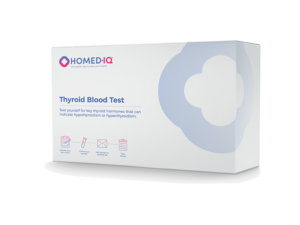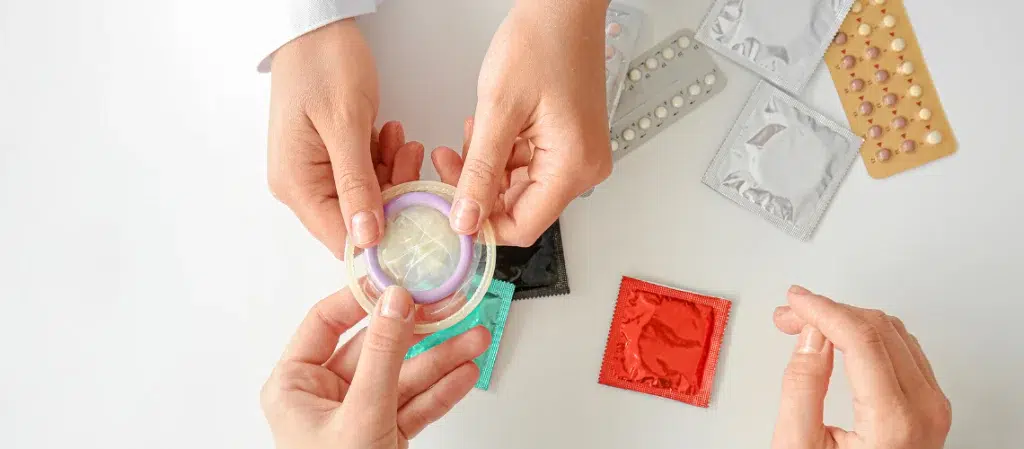Our thyroid is a relatively small and unknown organ, but it is also incredibly important to our bodies’ function. However, most people don’t know where the thyroid is in their body or what its purpose is. In this article we would like to shed some light on why it can be important to determine your TSH, T3 and T4 levels with Homed-IQ’s Thyroid Blood Test.
Table of contents
- What is the thyroid?
- What is TSH?
- What is FT3?
- What is FT4?
- Functions of FT3 and FT4
- How to measure your thyroid levels
- Interpretation of test results
What is the thyroid?
The thyroid is a gland that produces and secretes hormones in the body. In humans, the thyroid gland is located in the neck below the larynx and is colloquially referred to as the butterfly gland because its shape resembles two wings.
Our thyroid has three main jobs. Its most important function is to produce hormones that influence our metabolism, or the process that turns food into energy. Furthermore, the thyroid has an influence on our physical development and growth. Additionally, our thyroid gland is where iodine is stored in our bodies.
The thyroid produces two hormones that are very important for metabolism – T3 and T4. These two hormones regulate our entire metabolism and determine how it must work. When our thyroid does not function properly, our metabolism can either be too high or too low (NIH, 2010).
In addition to the three functions mentioned above, the thyroid influences countless other functions in the body. These include:
- Muscles and nerves
- Heart and circulation
- Sexuality and fertility
- Stomach and intestines
- Growth of nails, skin, and hair
- Mental well-being
Source: Society for Endocrinology, 2018
If you’ve read this far, you may have noticed just how broad the influence of the thyroid is. So, it’s no surprise that thyroid problems manifest themselves in a myriad of ways.
As already mentioned, the thyroid gland is an important storage location for iodine, because the thyroid gland needs iodine in combination with the thyroid-stimulating hormone (TSH) to produce T3 and T4. Since our body cannot produce iodine itself, it is dependent on an external supply from food.
What is TSH?
TSH is an abbreviation that stands for thyroid-stimulating hormone, which is also known as thyrotropin and is produced in the pituitary gland. If the hormone production in the thyroid gland is to be stimulated, TSH is released into the blood.
Therefore, the TSH value can be used to reflect the function of the thyroid gland. With high TSH values, hormone production in the thyroid gland must be stimulated, since the levels of the thyroid hormones thyroxine (T4) and triiodothyronine (T3) are too low.
It should be noted that TSH levels naturally fluctuate with age and throughout the day – younger and older people tend to have higher TSH levels, and that TSH peaks during the night before falling throughout the day.
TSH by age
Normal levels of TSH can vary depending on the test because different labs use different methods of measurement. As already mentioned, it is generally the case that babies have particularly high TSH levels, which fall quickly after the first year of life. Over the course of a lifetime, however, these values slowly begin to rise again.
| Age | TSH Normal Value | Low | High |
| 1. First week of life | 0.70 – 15.2 mU/L | < 0.70 mU/L | > 15.20 mU/L |
| 1 Week – 1 Year | 0.72 – 10.9 mU/L | < 0.72 mU/L | > 10.9 mU/L |
| 1 – 3 Years | 0.7 – 5.97 mU/L | < 0.7 mU/L | > 5.97 mU/L |
| 18 – 30 Years | 0.51 – 4.3 mU/L | < 0.51 mU/L | > 4.3 mU/L |
| 31 – 50 Years | 0.27 – 4.2 mU/L | < 0.27 mU/L | > 4.2 mU/L |
| 51 – 70 Years | 0.27 – 4.2 mU/L | < 0.27 mU/L | > 4.2 mU/L |
| 71 – 90 Years | 0.27 – 4.2 mU/L | < 0.27 mU/L | > 4.2 mU/L |
TSH levels in women
Women are more likely than men to have elevated TSH levels during menstruation, childbirth, and after menopause. A 2017 study found that older women with high TSH levels and thyroid nodules have a higher risk of developing thyroid cancer (Golbert et al., 2017).
TSH levels in men
Both high and low TSH levels can affect fertility. Both hypothyroid and hyperthyroid men have been found to have fewer sperm with normal shapes (Shomon, 2021).
In addition, compared to women, men with elevated TSH levels are more prone to problems such as abnormal development of the genitals. In men, drug treatment with thyroid hormones may be required to achieve TSH balance (Penn Medicine, 2019).
TSH levels in children
TSH levels in children fluctuate dramatically throughout their lives (Kapelari et al., 2008). TSH levels in children are typically high in the first month after birth, but drop steadily as they approach adulthood, before rising again as they get older.
What is FT3?
FT3 is one of the three main hormones made by the thyroid. FT3 stands for triiodothyronine. Both FT3 and FT4 are particularly important for the metabolism and thus have a great influence on the growth of the body (NIH, 2010).
What is FT4?
In addition to triiodothyronine, the thyroid also produces FT4. FT4 stands for thyroxine, which is also known as tetraiodothyronine. As already mentioned, both FT4 and FT3 are particularly important for the metabolism and therefore have a great influence on the growth of the body.
Functions of FT3 and FT4
FT3 and FT4 are involved in many processes in our body. These processes and functions include, but are not limited to:
- Stimulation of the metabolism
- Regulating the growth of cells through the release of growth hormones
- Heat production
- Influence on the glucose content in the body
- Mental development
- Oxygen consumption
Source: Endocrine Society, 2022
Symptoms of too much T3 or T4
Too much T3 and T4 hormones manifest themselves in different ways. In addition to the classic symptom of weight loss despite adequate nutrition, other symptoms are:
- Muscle tremors and nervousness
- Warm or moist skin
- Increased sweating
- Increased heart rate
- Generally higher basal energy consumption of the body
Source: Endocrine Society, 2022
Symptoms of too little T3 or T4
As mentioned, the thyroid is involved in many functions. Therefore, T3 and T4 deficiencies can manifest in many ways. These include:
- Powerlessness and lack of drive
- Unexplained weight gain and/or obesity
- Difficulty concentrating and remembering
- Fatigue
- Dry or cool skin
Source: Endocrine Society, 2022
How to measure your thyroid levels
The thyroid constantly releases varying amounts of T3 and T4 into the bloodstream. It is therefore possible to determine your thyroid values easily and reliably with one Homed-IQ’s home Thyroid Test. With this home test you can measure TSH, FT3 and FT4. The difference between T3 & FT3 and T4 & FT4 is that FT3 and FT4 are “free” thyroid hormones that are not bound to specific blood proteins. A thyroid test only measures FT3 and FT4 (and of course TSH).
Interpretation of test results
Too much or too little T3 and T4 in the bloodstream indicates an imbalance where the body has suboptimal levels of the necessary thyroid hormones.
TSH Interpretations
If the test result indicates an elevated TSH level, this means that the thyroid gland is underactive, also known as hypothyroidism. TSH levels show that too much TSH is being produced by the pituitary gland.
If, on the other hand, the test result indicates a low TSH value, this can indicate an overactive thyroid gland. In this case, the TSH levels show that the pituitary gland is producing too little TSH.
T3 and T4 interpretations
The interpretation is reversed for the T3 and T4 values. If the test result shows increased FT3 or FT4 values, it is highly likely that you have an overactive thyroid. If your FT3 or FT4 values are low, it is likely that you have an underactive thyroid.
How to support a healthy thyroid
The best and easiest way to support a healthy thyroid gland is to eat a healthy diet with adequate iodine and selenium intake. As the body cannot create iodine itself, it is dependent on an external supply through diet. Iodine and selenium are particularly important in the production of T3 and T4. Iodine is found in spinach, broccoli, and seaweed, among other things, while porcini mushrooms, herring, and tuna have a high selenium content.
Gain a better understanding of your thyroid function without visiting a doctor’s office using Homed-IQ’s Thyroid Blood Test. Click here to learn more.
References
Golbert, L., de Cristo, A. P., Faccin, C. S., Farenzena, M., Folgierini, H., Graudenz, M. S., & Maia, A. L. (2017). Serum TSH levels as a predictor of malignancy in thyroid nodules: A prospective study. PLOS ONE, 12(11), e0188123. https://doi.org/10.1371/journal.pone.0188123
How does the thyroid gland work? (2010, November 17). NIH. https://www.ncbi.nlm.nih.gov/books/NBK279388/
Infertility and Thyroid Disease. (2021, April 14). Verywell Health. https://www.verywellhealth.com/infertility-and-thyroid-disease-4019413
Kapelari, K., Kirchlechner, C., Högler, W., Schweitzer, K., Virgolini, I., & Moncayo, R. (2008). Pediatric reference intervals for thyroid hormone levels from birth to adulthood: a retrospective study. BMC Endocrine Disorders, 8(1). https://doi.org/10.1186/1472-6823-8-15
Penn Medicine. (2019, January 10). How Thyroid Problems Might Be Hurting Your Sex Life. Penn Medicine Women’s Health Blog. https://www.pennmedicine.org/updates/blogs/womens-health/2019/january/how-thyroid-problems-might-be-hurting-your-sex-life
Thyroid gland | You and Your Hormones from the Society for Endocrinology. (n.d.). https://www.yourhormones.info/glands/thyroid-gland/
TSH (Thyroid-Stimulating Hormone) Levels: Symptoms. (n.d.). Cleveland Clinic. https://my.clevelandclinic.org/health/articles/23524-thyroid-stimulating-hormone-tsh-levels





